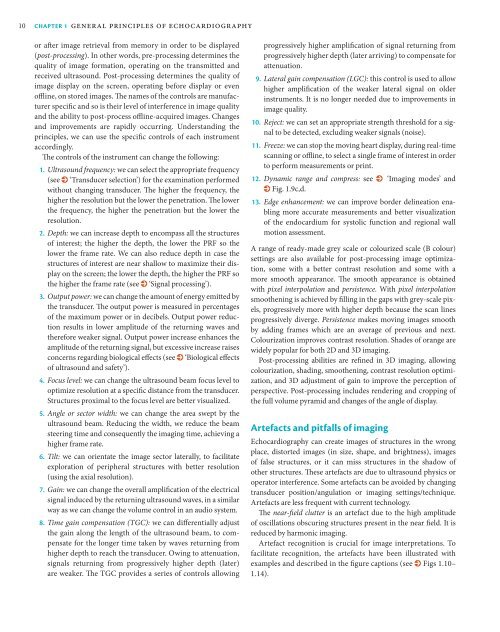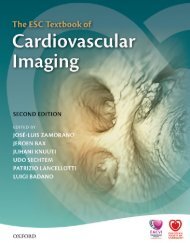EACVI Echocardiography Textbook - sample
Discover the EACVI Textbook of Echocardiography 2nd edition
Discover the EACVI Textbook of Echocardiography 2nd edition
Create successful ePaper yourself
Turn your PDF publications into a flip-book with our unique Google optimized e-Paper software.
10<br />
Chapter 1 general principles of echocardiography<br />
or after image retrieval from memory in order to be displayed<br />
(post-processing). In other words, pre-processing determines the<br />
quality of image formation, operating on the transmitted and<br />
received ultrasound. Post-processing determines the quality of<br />
image display on the screen, operating before display or even<br />
offline, on stored images. The names of the controls are manufacturer<br />
specific and so is their level of interference in image quality<br />
and the ability to post-process offline-acquired images. Changes<br />
and improvements are rapidly occurring. Understanding the<br />
principles, we can use the specific controls of each instrument<br />
accordingly.<br />
The controls of the instrument can change the following:<br />
1. Ultrasound frequency: we can select the appropriate frequency<br />
(see % ‘Transducer selection’) for the examination performed<br />
without changing transducer. The higher the frequency, the<br />
higher the resolution but the lower the penetration. The lower<br />
the frequency, the higher the penetration but the lower the<br />
resolution.<br />
2. Depth: we can increase depth to encompass all the structures<br />
of interest; the higher the depth, the lower the PRF so the<br />
lower the frame rate. We can also reduce depth in case the<br />
structures of interest are near shallow to maximize their display<br />
on the screen; the lower the depth, the higher the PRF so<br />
the higher the frame rate (see % ‘Signal processing’).<br />
3. Output power: we can change the amount of energy emitted by<br />
the transducer. The output power is measured in percentages<br />
of the maximum power or in decibels. Output power reduction<br />
results in lower amplitude of the returning waves and<br />
therefore weaker signal. Output power increase enhances the<br />
amplitude of the returning signal, but excessive increase raises<br />
concerns regarding biological effects (see % ‘Biological effects<br />
of ultrasound and safety’).<br />
4. Focus level: we can change the ultrasound beam focus level to<br />
optimize resolution at a specific distance from the transducer.<br />
Structures proximal to the focus level are better visualized.<br />
5. Angle or sector width: we can change the area swept by the<br />
ultrasound beam. Reducing the width, we reduce the beam<br />
steering time and consequently the imaging time, achieving a<br />
higher frame rate.<br />
6. Tilt: we can orientate the image sector laterally, to facilitate<br />
exploration of peripheral structures with better resolution<br />
(using the axial resolution).<br />
7. Gain: we can change the overall amplification of the electrical<br />
signal induced by the returning ultrasound waves, in a similar<br />
way as we can change the volume control in an audio system.<br />
8. Time gain compensation (TGC): we can differentially adjust<br />
the gain along the length of the ultrasound beam, to compensate<br />
for the longer time taken by waves returning from<br />
higher depth to reach the transducer. Owing to attenuation,<br />
signals returning from progressively higher depth (later)<br />
are weaker. The TGC provides a series of controls allowing<br />
progressively higher amplification of signal returning from<br />
progressively higher depth (later arriving) to compensate for<br />
attenuation.<br />
9. Lateral gain compensation (LGC): this control is used to allow<br />
higher amplification of the weaker lateral signal on older<br />
instruments. It is no longer needed due to improvements in<br />
image quality.<br />
10. Reject: we can set an appropriate strength threshold for a signal<br />
to be detected, excluding weaker signals (noise).<br />
11. Freeze: we can stop the moving heart display, during real-time<br />
scanning or offline, to select a single frame of interest in order<br />
to perform measurements or print.<br />
12. Dynamic range and compress: see % ‘Imaging modes’ and<br />
% Fig. 1.9c,d.<br />
13. Edge enhancement: we can improve border delineation enabling<br />
more accurate measurements and better visualization<br />
of the endocardium for systolic function and regional wall<br />
motion assessment.<br />
A range of ready-made grey scale or colourized scale (B colour)<br />
settings are also available for post-processing image optimization,<br />
some with a better contrast resolution and some with a<br />
more smooth appearance. The smooth appearance is obtained<br />
with pixel interpolation and persistence. With pixel interpolation<br />
smoothening is achieved by filling in the gaps with grey-scale pixels,<br />
progressively more with higher depth because the scan lines<br />
progressively diverge. Persistence makes moving images smooth<br />
by adding frames which are an average of previous and next.<br />
Colourization improves contrast resolution. Shades of orange are<br />
widely popular for both 2D and 3D imaging.<br />
Post-processing abilities are refined in 3D imaging, allowing<br />
colourization, shading, smoothening, contrast resolution optimization,<br />
and 3D adjustment of gain to improve the perception of<br />
perspective. Post-processing includes rendering and cropping of<br />
the full volume pyramid and changes of the angle of display.<br />
Artefacts and pitfalls of imaging<br />
<strong>Echocardiography</strong> can create images of structures in the wrong<br />
place, distorted images (in size, shape, and brightness), images<br />
of false structures, or it can miss structures in the shadow of<br />
other structures. These artefacts are due to ultrasound physics or<br />
operator interference. Some artefacts can be avoided by changing<br />
transducer position/angulation or imaging settings/technique.<br />
Artefacts are less frequent with current technology.<br />
The near-field clutter is an artefact due to the high amplitude<br />
of oscillations obscuring structures present in the near field. It is<br />
reduced by harmonic imaging.<br />
Artefact recognition is crucial for image interpretations. To<br />
facilitate recognition, the artefacts have been illustrated with<br />
examples and described in the figure captions (see % Figs 1.10–<br />
1.14).





